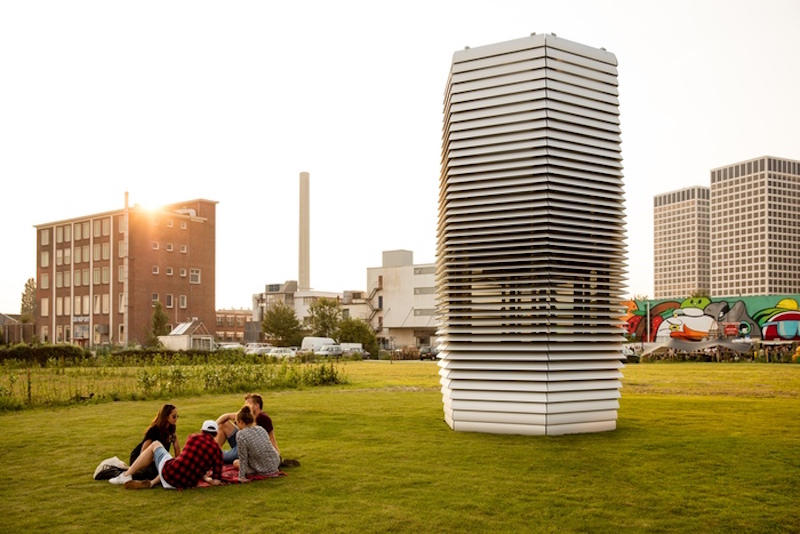According to the World Health organization, around 2.4 million deaths that occur in China every year can be attributed to air pollution. The thick pollution found in many rapidly developing Chinese cities creates and exacerbates asthma and cardiovascular issues, resulting in premature death.
As Architectural Digest reports, new, stricter emissions regulations are stymieing the amount of dangerous particulate matter in the air, but pollution levels are still well above what is considered safe or acceptable.
If only someone could develop a scaled-up version of a common indoor air purifier that could be used to help purify the air outside, maybe some relief could finally come to many smog-filled cities. But that’s not plausible, is it? Well, apparently it is, as someone has done just that. A Netherlands-based team led by Dutch designer Daan Roosegaarde has created what is essentially a 23-ft tall outdoor air purifier to help clean the air of some of the world’s most polluted cities.
The structure uses ion technology to attract about 30,000 cubic meters of pollution per hour and operates almost exclusively on wind energy. While the amount of pollution one of these towers can filter is just a drop in the bucket for China’s polluted cities, deploying them in large numbers around the country could create a significant impact. Similarly to photovoltaic solar panels, one may not provide much benefit, but when used in large numbers, their output increases exponentially.
In an effort to raise funds for the project, Roosegaarde launched a Kickstarter campaign where backers could receive cubes, rings, and cufflinks made from the compressed particulate matter, mainly carbon, collected from the filter. According to the Kickstarter page, each Smog Free ring acts as a symbol of 1000 cubic meters of clean air.
The campaign raised €113,153, easily surpassing its goal of €50,000. It is thanks to the funds raised through the Kickstarter campaign that allowed the Smog Free Project to travel and open in Beijing on Sept. 29. The filter will also travel to additional Chinese cities and is looking into traveling to India and other countries around the world, as well.
Related Stories
Green | Jul 8, 2024
Global green building alliance releases guide for $35 trillion investment to achieve net zero, meet global energy transition goals
The international alliance of UK-based Building Research Establishment (BRE), the Green Building Council of Australia (GBCA), the Singapore Green Building Council (SGBC), the U.S. Green Building Council (USGBC), and the Alliance HQE-GBC France developed the guide, Financing Transformation: A Guide to Green Building for Green Bonds and Green Loans, to strengthen global cooperation between the finance and real estate sectors.
Sustainability | Jul 1, 2024
Amazon, JPMorgan Chase among companies collaborating with ILFI to advance carbon verification
Four companies (Amazon, JPMorgan Chase, JLL, and Prologis) are working with the International Living Future Institute to support development of new versions of Zero Carbon Certification.
Sustainability | Jun 24, 2024
CBRE to use Climate X platform to help clients calculate climate-related risks
CBRE will use risk analysis platform Climate X to provide climate risk data to commercial renters and property owners. The agreement will help clients calculate climate-related risks and return on investments for retrofits or acquisitions that can boost resiliency.
Building Technology | Jun 18, 2024
Could ‘smart’ building facades heat and cool buildings?
A promising research project looks at the possibilities for thermoelectric systems to thermally condition buildings, writes Mahsa Farid Mohajer, Sustainable Building Analyst with Stantec.
University Buildings | Jun 18, 2024
UC Riverside’s new School of Medicine building supports team-based learning, showcases passive design strategies
The University of California, Riverside, School of Medicine has opened the 94,576-sf, five-floor Education Building II (EDII). Created by the design-build team of CO Architects and Hensel Phelps, the medical school’s new home supports team-based student learning, offers social spaces, and provides departmental offices for faculty and staff.
Codes and Standards | Jun 17, 2024
Federal government releases national definition of a zero emissions building
The U.S. Department of Energy has released a new national definition of a zero emissions building. The definition is intended to provide industry guidance to support new and existing commercial and residential buildings to move towards zero emissions across the entire building sector, DOE says.
Green | Jun 11, 2024
Tool helps construction and renovation projects with CalGreen compliance
One Click LCA recently launched a new software tool to help building teams comply with Part 11, Title 24, of the California Code of Regulations—CALGreen. The regulation is the nation’s first state-mandated green building code to include embodied carbon emission control as a mandatory component, effective from July 1, 2024.
Mass Timber | May 31, 2024
Mass timber a big part of Western Washington University’s net-zero ambitions
Western Washington University, in Bellingham, Wash., 90 miles from Seattle, is in the process of expanding its ABET-accredited programs for electrical engineering, computer engineering and science, and energy science. As part of that process, the university is building Kaiser Borsari Hall, the 54,000-sf new home for those academic disciplines that will include teaching labs, research labs, classrooms, collaborative spaces, and administrative offices.
MFPRO+ New Projects | May 29, 2024
Two San Francisco multifamily high rises install onsite water recycling systems
Two high-rise apartment buildings in San Francisco have installed onsite water recycling systems that will reuse a total of 3.9 million gallons of wastewater annually. The recycled water will be used for toilet flushing, cooling towers, and landscape irrigation to significantly reduce water usage in both buildings.
MFPRO+ News | May 28, 2024
ENERGY STAR NextGen Certification for New Homes and Apartments launched
The U.S. Environmental Protection Agency recently launched ENERGY STAR NextGen Certified Homes and Apartments, a voluntary certification program for new residential buildings. The program will increase national energy and emissions savings by accelerating the building industry’s adoption of advanced, energy-efficient technologies, according to an EPA news release.

















